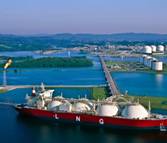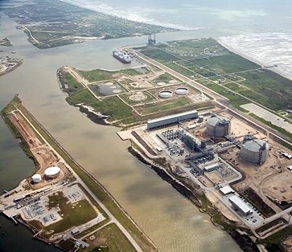US shale boom threatens Australian gas sector
By ROSS KELLY
BRISBANE, Australia -- More than $160 billion of bets placed by international oil companies including Chevron and ExxonMobil on natural gas in Australia are getting riskier, as the country becomes the latest major energy producer to grapple with North America's surging output of shale gas.
Once a global hot spot for energy investment due to its political stability and large, untapped natural-gas reserves, Australia's appeal has waned as labor shortages and a high Australian dollar have trigger cost blowouts at flagship projects.
Although those problems have been around for a while, they are becoming more worrisome now that gas prices elsewhere have dropped and buyers have more options for securing energy supply.
"The industry has more than $160 billion of liquefied natural gas investments currently in flight [being built]. But upwards of another $100 billion in potential future projects could be at risk," said Roy Krzywosinski, managing director of Chevron Australia.
Australia has long harbored ambitions of becoming the major LNG supply hub for Asia and has over a dozen projects either under construction or on the drawing board. The seven terminals currently being built should allow Australia to leapfrog Qatar as the world's biggest LNG exporter by 2018.
 However, further supply additions may prove harder to achieve. Costs are rising sharply and first cargoes are being delayed at existing projects, hurting returns on investment. These problems are making companies wary of expanding or building new projects in Australia.
However, further supply additions may prove harder to achieve. Costs are rising sharply and first cargoes are being delayed at existing projects, hurting returns on investment. These problems are making companies wary of expanding or building new projects in Australia.
Chevron and partners Exxon and Shell have delayed work to expand their $52 billion Gorgon project. Gorgon is Australia's largest natural-gas resource, containing an estimated 50 trillion cubic feet of natural gas -- enough to meet US demand for two years. Chevron is the project's operator and largest shareholder.
A rival nearby project that has yet to get off the ground, known as Browse, suffered an even bigger setback in April when operator Woodside Petroleum scrapped plans for an onshore gas-export plant because of high construction costs. Woodside is now looking at new floating LNG technology that would process the gas at sea, and this has delayed the project by at least two years. Shell is also an investor in Browse.
Project delays carry large risks for companies like Chevron as future supply from Australia would compete for customers with US projects offering cheaper gas. LNG in Asia has traditionally been sold via long-term contracts, with prices linked to relatively expensive crude oil, whereas export deals in North America are based on sharply lower domestic gas prices there. Analysts think Australian gas-export prices may need to fall by as much as 25% to compete with US gas prices.
Big LNG importers like Korea Gas and Japan's Osaka Gas have signed long-term agreements with US terminals, diversifying supply sources that until now relied heavily on Australia and the Middle East.
"The focus is on the US now. The first [export] projects are under way [in the US], and we expect more to come through," said Andrew McManus, a consultant at UK-based Wood Mackenzie, which is forecasting around 50 million tons of annual LNG exports from the US by 2020. That is equivalent to more than half of Australia's projected supply of exports in that year.
 In May, the US approved Freeport LNG's $10 billion Quintana LNG-export project in Texas, the second US development to move forward after Cheniere Energy's Sabine Pass project in Louisiana. Both involve converting old LNG import terminals into export facilities, making them cheaper to build than Australian projects because infrastructure -- such as pipelines and storage tanks -- is already in place.
In May, the US approved Freeport LNG's $10 billion Quintana LNG-export project in Texas, the second US development to move forward after Cheniere Energy's Sabine Pass project in Louisiana. Both involve converting old LNG import terminals into export facilities, making them cheaper to build than Australian projects because infrastructure -- such as pipelines and storage tanks -- is already in place.
To be sure, US gas exports remain a contentious issue in Washington because of the potential effect on domestic users. Canadian exports, however, are on the horizon beginning in 2017. Companies with big discoveries off the coast of East Africa are also looking to start shipping gas by the end of the decade.
Confidence in Australia's LNG industry suffered its heaviest blow in December, when Chevron said the cost of its Gorgon venture with Exxon and Shell had ballooned by 40% and that the first shipments of LNG from Gorgon would occur in 2015, several months later than planned.
Chevron largely blamed a 20% jump in the Australian dollar's value since construction began in 2009, which makes it more expensive to buy equipment locally, and bad weather. But it also underestimated the wages needed to entice workers to the plant site at Barrow Island, a nature reserve off the coast of Western Australia state that is home to rare turtles and birds. Chevron must compete with other LNG and mining projects to attract workers to the remote location.
"Everything in Australia's been built. It doesn't look good for new projects," says Noelle Leonard, a consultant at Facts Global Energy. "We don't see any developments taking a final investment decision for at least a year or more. And if they do, the natural progression will be toward expanding existing facilities."
Woodside Petroleum's Browse leads a list of stalled projects, which includes a joint venture between Shell and PetroChina called Arrow Energy that aims to convert gas trapped in coal seams to LNG for export in eastern Australia's Queensland state.
Rising costs for building LNG projects have become a significant challenge for companies doing business in Australia, Peter Voser, Shell's retiring CEO, told industry leaders in May.
Despite the delays and a $15 billion increase in capital costs for the Gorgon project -- damping returns and postponing cash flow -- Chevron says Gorgon will still make money. The project's Asian customers are locked into contracts typically lasting 20 years, guaranteeing demand for the gas.
And the contracts are linked to the fluctuating price of oil, which is up about 50% since construction began in September 2009 -- allowing Chevron and its partners to reap more for the gas as long as oil prices remain high.
But in a sign the company's appetite for Australian LNG is waning, Chevron said in December that a decision on whether to start early design work on expanding Gorgon to include a fourth gas-processing unit would be delayed by at least a year and won't happen before the final months of 2013.
"We have the gas. It's just a matter of seeing where this investment climate settles," Mr. Krzywosinski said.
Dow Jones Newswires






Comments